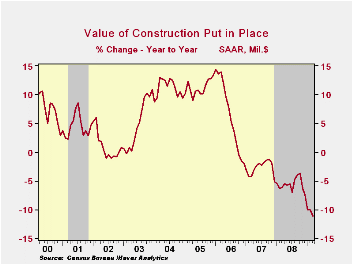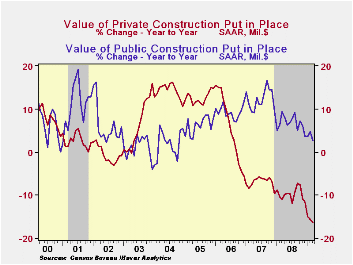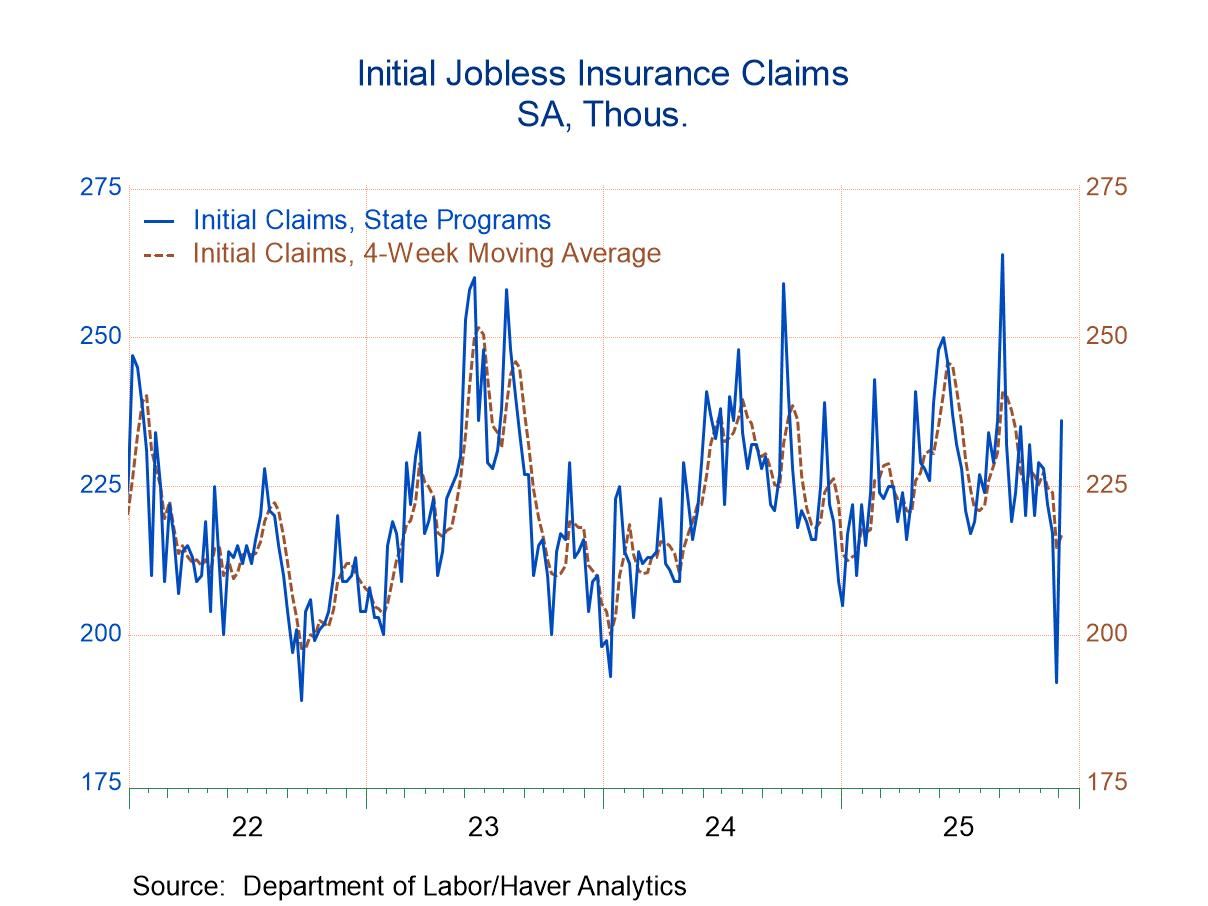 Global| May 04 2009
Global| May 04 2009U.S. Construction Spending Improvement Due to Nonresidential & Public Sector Gains
by:Tom Moeller
|in:Economy in Brief
Summary
Regrettably, recent gains in the value of construction spending have been limited, small and tenuous. The value of construction put-in-place unexpectedly increased 0.3% during March following five consecutive months of decline in [...]

Regrettably, recent gains in the value of construction spending have been limited, small and tenuous. The value of construction put-in-place unexpectedly increased 0.3% during March following five consecutive months of decline in excess of 3% each month. Consensus expectations had been for a 1.5% drop.
A 2.0% jump in the value of nonresidential building activity accounted for much of the March surprise. The collapse of corporate profits, however, has dropped the y/y gain to just 1.7% after double-digit increases during the prior three years. The March increase reflected gains in the lodging (-5.1% y/y), commercial (-20.5 y/y), health care (+3.9% y/y), and educational (5.4% y/y) sectors.
Public construction also was strong during March and posted a 1.1% increase. The recession's effect on tax revenues, however, seems to be taking hold. The small 2.6% year-to-year increase in the level of activity for March left the first quarter's level just equal to the 2008 average. The value of spending on transportation facilities did rise 1.7% in March but it was down 6.0% year-to-year while spending on highways & streets fell 0.8% (-2.2% y/y) and was down for the fourth straight month. The value of construction on highways & streets is roughly one-third of the value of total public construction spending.
The value of residential building activity continued down hard and it posted a 4.2% decline, off by one-third over the last year. Notably hard hit has been single-family construction activity which fell 8.6% in March and is off by one-half during the last twelve months. Building activity on multi-family units has held up relatively well and posted a March decline of just 1.1% (-13.7% y/y). Spending on improvements fell 1.0% (-13.1% y/y).
During the last twenty years there has been an 84% correlation between the q/q change in the value of residential building and its contribution to growth in real GDP.
The more detailed categories of construction represent the Census Bureau’s reclassification of construction activity into end-use groups. Finer detail is available for many of the categories; for instance, commercial construction is shown for automotive sales and parking facilities, drugstores, building supply stores, and both commercial warehouses and mini-storage facilities. Note that start dates vary for some seasonally adjusted line items in 2000 and 2002, and that constant-dollar data are no longer computed.
The construction put-in-place figures are available in Haver's USECON database.
| Construction (%) | March | February | Y/Y | 2008 | 2007 | 2006 |
|---|---|---|---|---|---|---|
| Total | 0.3 | -1.0 | -11.1 | -5.7 | -2.7 | 6.3 |
| Private | -0.1 | -2.1 | -16.3 | -9.8 | -6.9 | 5.5 |
| Residential | -4.2 | -5.9 | -34.0 | -27.7 | -19.8 | 1.0 |
| Nonresidential | 2.7 | 0.7 | 1.2 | 14.9 | 19.6 | 16.2 |
| Public | 1.1 | 1.3 | 2.6 | 6.7 | 12.3 | 9.3 |
Tom Moeller
AuthorMore in Author Profile »Prior to joining Haver Analytics in 2000, Mr. Moeller worked as the Economist at Chancellor Capital Management from 1985 to 1999. There, he developed comprehensive economic forecasts and interpreted economic data for equity and fixed income portfolio managers. Also at Chancellor, Mr. Moeller worked as an equity analyst and was responsible for researching and rating companies in the economically sensitive automobile and housing industries for investment in Chancellor’s equity portfolio. Prior to joining Chancellor, Mr. Moeller was an Economist at Citibank from 1979 to 1984. He also analyzed pricing behavior in the metals industry for the Council on Wage and Price Stability in Washington, D.C. In 1999, Mr. Moeller received the award for most accurate forecast from the Forecasters' Club of New York. From 1990 to 1992 he was President of the New York Association for Business Economists. Mr. Moeller earned an M.B.A. in Finance from Fordham University, where he graduated in 1987. He holds a Bachelor of Arts in Economics from George Washington University.






